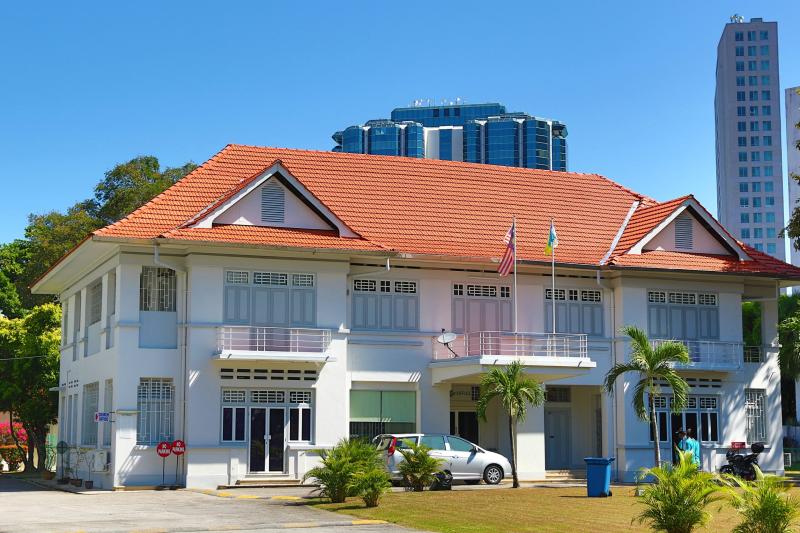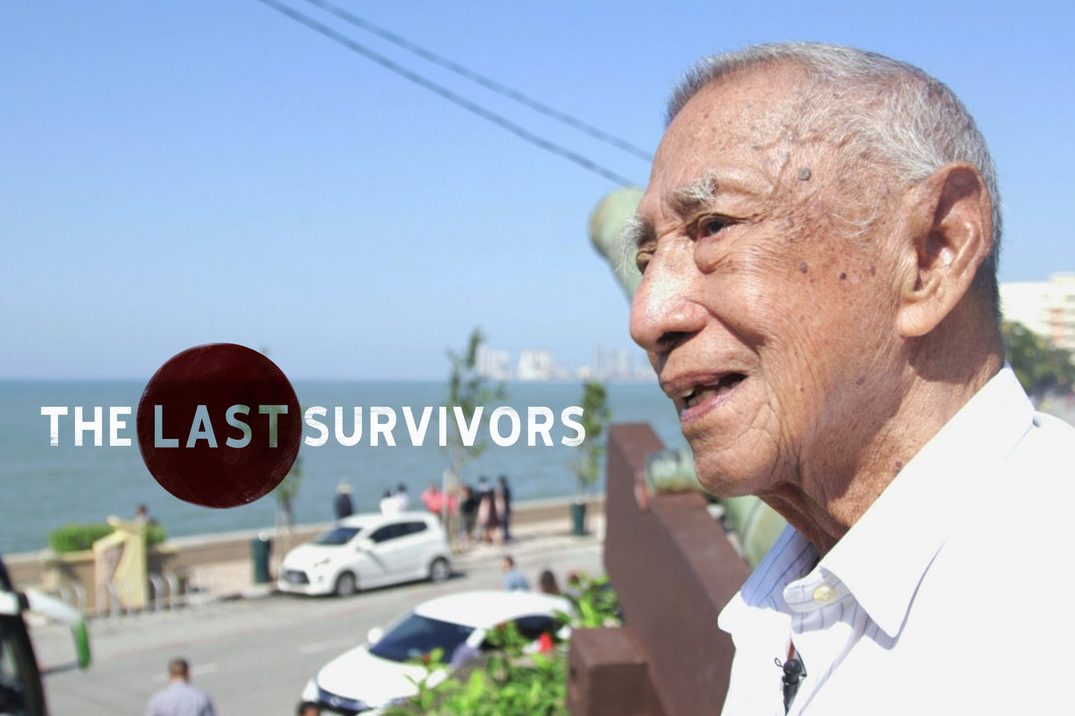By NATASHA VENNER-PACK
Staring out to sea on Fort Cornwallis, James Jeremiah cuts a lonely figure.
“Before the fighting started, we were so excited to shoot the Japanese. We had never seen war; we had only seen it in the movies,” said Jeremiah. “But the first time I heard a real bomb, I was scared to death.”
That was at the old Bayan Lepas Airport, where Jeremiah witnessed the beginning of the Japanese invasion of Penang. He was 18 at the time, and a member of the Eurasian “E” company of Penang, a volunteer force similar to the British Home Guard.
“We thought the Japanese would fly in from Batu Maung in the south, but they came in through Tanjung Bungah and Batu Ferringhi. I think they knew we were focused on the south.”
The tactic worked. The volunteers mistook the Japanese planes for British fighters, a mistake that almost cost them their lives.
“They turned out to be Japanese Zero fighters. They started bombing and machine gunning us. Shrapnel was flying everywhere. I cannot even describe the fear we had in our hearts,” he said.
Although they were trained to a certain extent, the Volunteer Forces (VF) were not hardened military men.

WWII survivor James Jeremiah was part of the Volunteer Forces at Fort Cornwallis before the invasion of Penang.
The invasion
My father had rather dark skin, which I inherited. I think it saved my life!
After the bombing, it was only a matter of time before Japanese ground troops arrived.
Even then, the volunteer forces regrouped at their headquarters on Peel Avenue, and did their best to maintain order.
With the British gone and the Japanese at their doorstep, people were looting ruined houses and bodies were strewn everywhere from the bombing.
“We carried the dead bodies away, assisted the wounded and stopped all looters.
“It’s no joke when you’re in that situation – we just didn’t know what to do,” said Jeremiah.
Things quickly got worse when the Japanese arrived. The Volunteer Forces were rounded up, and the Europeans and fair-skinned Eurasians were sent to Singapore to be held as prisoners of war.
“My father had rather dark skin, which I inherited. I think it saved my life!” said Jeremiah.
The remaining VF members were used by the Japanese as guides. Jeremiah’s work ethic as a guide caught the eye of a member of the Kempeitai, the feared Japanese military police.
“Colonel Watanabe took me to his office and asked what work I could do, so I said anything. He asked me to make tea, coffee, polish his boots – things like that.”

The Wesley Methodist Church compound today. It was used as the Kempeitai office, and James was forced to endure the screams of those being tortured there.
A church and a torture chamber
I used to hear screams, cries… I couldn’t take it.
The Kempeitai office was located in the Wesley Methodist Church on Jalan Burma. Although he was a mere office boy, the experience was terrifying.
He still lives on Penang island today, a mere 20 minutes from the church – but he has never gone back to the church in over 70 years, until he brought R.AGE there last month to shoot an episode of The Last Survivors.
“I used to see people being arrested. I don’t know how, but they were ‘interrogated’. I used to hear screams, cries… I couldn’t take it,” he said in the video, which is part of a series documenting the stories of Malaysia’s WWII survivors.
Although the brutality of the Kempeitai has haunted many, including Jeremiah, not all the Japanese were cruel overlords.
Watanabe was educated in the United States, and he saved Jeremiah’s life a few times.
The Japanese would hold “trials” at public spaces – including Padang Kota Lama next to Fort Cornwallis – where their local informants would expose other locals who were working against the Japanese.
“(The informants) wore hoods when they pointed people out. The minute they point at you, you’re finished, gone,” said Jeremiah. “The Japanese would round up the public so the informants could point people out.”
Jeremiah thanks Watanabe for saving him from attending the trials, where he believes he could easily have been singled out for execution. “Watanabe protected me. I was so lucky, he was very good to me.”
Some of the informants flaunted their special privilege with the Japanese, according to Jeremiah.
“They would say ‘don’t mess with us’, so we kept quiet. I remember a famous Eurasian doctor, Doctor J.E. Smith, who was done in by them and, I think, beheaded.”

Jeremiah said it had been 70 years since he was last at Wesley Methodist, and that he’ll never go back again.
An act of kindness
Even with Watanabe’s protection, the atrocities being committed at the Kempeitai office was too much for Jeremiah to bear, and he asked to be transfered to the railways. The colonel relunctantly agreed.
Watanabe continued showing kindness to Jeremiah even after he started work as a locomotive driver, putting in a good word to his new boss and General Yamashita himself, the mastermind behind the invasion of Malaya. Yamashita had defeated the combined Australian, British and Indian force of 130,000 soldiers with just 30,000 troops.
“Yamashita was riding the train along with Tadashi Suzuki (an infamous samurai sword-wielding executioner), but I couldn’t understand what they were saying as it was in Japanese,” said Jeremiah. “They noticed that my new boss’ boots were shining, and Watanabe said I was the one who polished them.”
The general made a lasting impression on young Jeremiah, who said the very sight of him made everyone afraid.
“He was very fierce and very dynamic, though very big and chubby. Everyone was afraid. I didn’t dare look him in the eye.”
While many struggled for food during the Occupation, Jeremiah said he was lucky to be paid in both “banana money” – the Japanese currency – and food.
“I used to get about 30 dollars a week, sometimes more. I saved the bread for my parents and if I wanted an egg, I’d ask Watanabe.”
Had he been caught smuggling eggs, the colonel would have beheaded him.

Jeremiah and R.AGE journalist Vivienne Wong walk through the old fort at Batu Maung, now a private museum.
Life before the war
I travelled all the way to Bangkok after the war to find her!
The horrors of the Occupation were a far cry from Jeremiah’s pre-war days.
Jeremiah was rotated around a few places, including Fort Auchry (now a Malaysian army camp), Fort Cornwallis and Batu Maung.
He remembers watching the Europeans and Eurasians boarding ships at Swettenham Pier heading to Singapore, where they believed they would be safe. Winston Churchill had insisted Singapore would not fall.
He was also posted at Batu Maung, a British fort which the Japanese turned into a torture chamber.
He brought the Last Survivors crew there during filming. The original fort remains, but the land is now a privately owned museum-cum-theme park, with plastic “ghosts” hanging everywhere and a paintball field attached.
“Everything has changed,” said Jeremiah with a laugh. “I don’t remember any of this being here!”
Jeremiah spent the rest of the war as a locomotive driver. After the war, he worked at the Batu Ferringhi reservoir, where he would retire as a superintendent.
While he experienced many horrors during the war, something beautiful did come out of it. He met his late wife, a former Miss Thailand, during his time on the railways.
“I travelled all the way to Bangkok after the war to find her,” said Jeremiah with a wide smile.
“All I had was her name, as her letters never had a return address.”
Though he lives on, happily surrounded by his children and grandchildren, Jeremiah said young Malaysians need to find out about their grandparents’ experiences.
“War is something that hurts everyone – it’s not like what you see in the movies. They should find out; they need to be told what happened.”
Today, he has outlived all 18 members of the “E” Company, all five of his siblings, and one of his children.
“All my friends and colleagues are now gone. I am the last survivor.”



Leave a reply